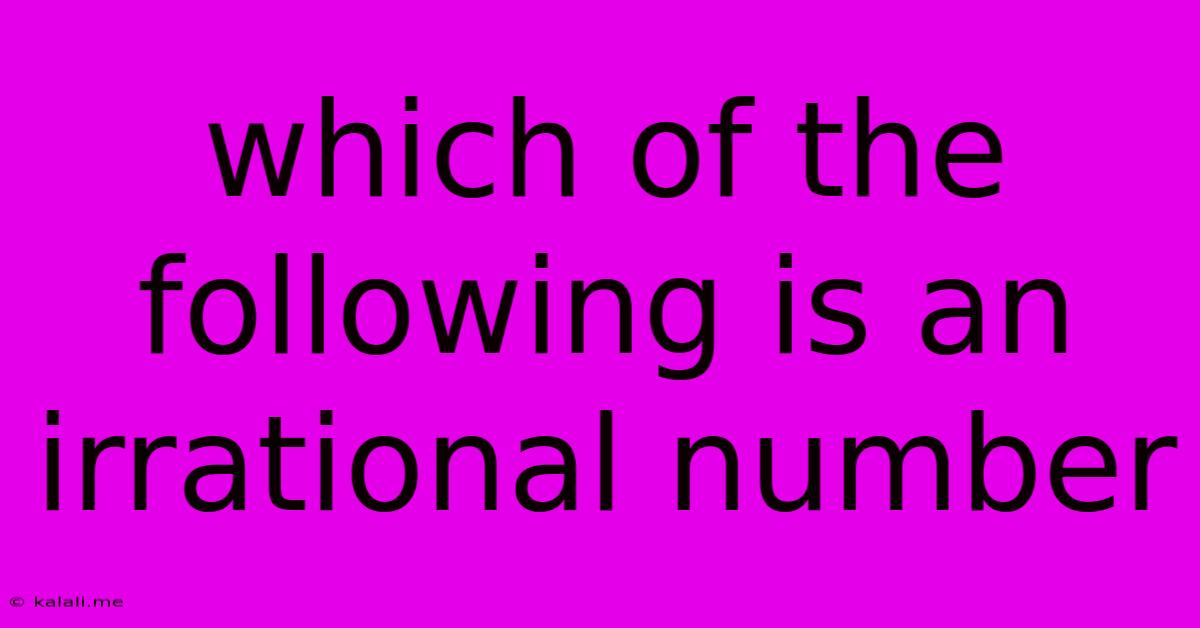Which Of The Following Is An Irrational Number
Kalali
Jun 14, 2025 · 2 min read

Table of Contents
Which of the Following is an Irrational Number? Understanding Irrational Numbers
This article will explore the concept of irrational numbers and help you identify them within a given set. Understanding irrational numbers is crucial for a solid foundation in mathematics. We'll define what makes a number irrational and provide clear examples to solidify your understanding. By the end, you'll be able to confidently distinguish between rational and irrational numbers.
What is an Irrational Number?
An irrational number is a real number that cannot be expressed as a simple fraction, or a ratio, of two integers (a numerator and a denominator where the denominator is not zero). This means it cannot be written exactly as a terminating decimal or a repeating decimal. Instead, its decimal representation goes on forever without repeating.
Key Characteristics of Irrational Numbers:
- Non-terminating and non-repeating decimals: This is the defining characteristic. The decimal expansion continues infinitely without ever settling into a repeating pattern.
- Cannot be expressed as a fraction: This is the fundamental definition. You cannot find two integers that, when divided, will give you the exact value of an irrational number.
- Examples: The most famous irrational numbers are π (pi) and e (Euler's number). The square root of any non-perfect square is also irrational (e.g., √2, √3, √5).
Distinguishing Irrational Numbers from Rational Numbers:
Let's contrast irrational numbers with their counterparts, rational numbers. Rational numbers can be expressed as a fraction p/q, where p and q are integers, and q is not zero. Their decimal representations either terminate (end) or repeat in a predictable pattern.
Examples of Rational Numbers:
- 1/2 = 0.5 (terminating decimal)
- 1/3 = 0.3333... (repeating decimal)
- -4 (can be expressed as -4/1)
- 0.75 (can be expressed as 3/4)
Identifying Irrational Numbers in a Set:
To identify irrational numbers from a given set, look for numbers that fit the characteristics mentioned above: non-terminating and non-repeating decimal expansions, or those that cannot be expressed as a simple fraction.
Let's consider a hypothetical example:
Which of the following numbers is irrational?
A. 0.75 B. 2/3 C. √7 D. 0.333...
The correct answer is C. √7.
- A and B are rational because they can be expressed as fractions (3/4 and 2/3, respectively).
- D is rational because it's a repeating decimal (1/3).
- C is irrational because 7 is not a perfect square, and its square root has a non-terminating, non-repeating decimal expansion.
In Conclusion:
Identifying irrational numbers requires understanding their defining characteristic: the inability to be expressed as a fraction of two integers, resulting in a non-terminating and non-repeating decimal representation. By applying this knowledge, you can effectively differentiate between rational and irrational numbers within any given set. Remember to consider square roots of non-perfect squares and well-known irrational constants like π and e. Practicing with examples will further solidify your understanding of this important mathematical concept.
Latest Posts
Latest Posts
-
If A Waves Frequency Doubles Its Wavelength
Jun 14, 2025
-
New Mexico State University Admission Requirements
Jun 14, 2025
-
What Is Not Required For Photosynthesis
Jun 14, 2025
-
Days To Celebrate In April 2024
Jun 14, 2025
-
What Is Not Found In A Animal Cell
Jun 14, 2025
Related Post
Thank you for visiting our website which covers about Which Of The Following Is An Irrational Number . We hope the information provided has been useful to you. Feel free to contact us if you have any questions or need further assistance. See you next time and don't miss to bookmark.